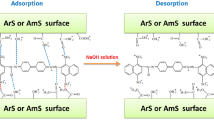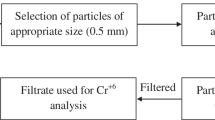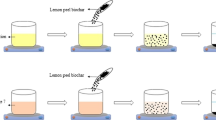Abstract
The potential of raw date pits as a natural, widely available and low-cost agricultural waste has been studied in order to adsorb cationic dyes from an aqueous solution. Date pits were characterized by FTIR, SEM, BET, and XRD analysis. To optimize removal of two industrial dyes, basic red 2 (BR2) and methyl violet (MV), from aqueous solution using date pits, response surface methodology (RSM) is employed. Tests were carried out as per central composite design (CCD) with four input parameters namely contact time, temperature, initial concentration of adsorbate, and pH. Second-order polynomial model better fits experimental data for BR2 and MV and optimum values were then determined. In the optimum conditions, kinetic study was conducted and the pseudo-second-order model was found the best fitted model compared to pseudo-first-order model. Moreover, it was shown that intraparticle diffusion was not the sole controlling step and could be associated with other transfer resistance. On other hand, equilibrium isotherms were obtained for BR2 and MV and their maximum adsorption capacities were 92 and 136 mg g−1 respectively. Two-parameter isotherm models like Langmuir, Temkin, Freundlich, Dubinin–Radushkevich, and Halsay were investigated to fit equilibrium data. Three error functions of residual root mean square error, chi-square statistic, and average relative error were used to comfort us in the selected models, which were actually Dubinin–Radushkevich and Langmuir for BR2 and Frendlich, Temkin, and Halsay for MV.











Similar content being viewed by others
References
Abdelwahab O (2007) Kinetic and isotherm studies of copper (II) removal from wastewater using various adsorbents. Egypt J Aquat Res 33:125–143
Adegoke KA, Bello OS (2015) Dye sequestration using agricultural wastes as adsorbents. Water Res Ind 12:8–24
Adinarayana K, Ellaiah P (2002) Response surface optimization of the critical medium components for the production of alkaline protease by a newly isolated Bacillus sp. J Pharm Pharm Sci 5:272–278
Ahmad AA, Hameed BH, Ahmad AL (2009) Removal of disperse dye from aqueous solution using waste-derived activated carbon: optimization study. J Hazard Mater 170:612–619
Ahmed MJ, Theydan SK (2014) Adsorptive removal of p-nitrophenol on microporous activated carbon by FeCl3 activation: equilibrium and kinetics studies. Desalin Water Treat 670:1–10
Alam Z, Muyibi SA, Toramae J (2007) Statistical optimization of adsorption processes for removal of 2,4-dichlorophenol by activated carbon derived from oil palm empty fruit bunches. J Environ Sci 19:674–677
Al-Ghouti MA, Hawari A, Khraisheh M (2013) A solid-phase extractant based on microemulsion modified date pits for toxic pollutants. J Environ Manag 130:80–89
Al-Ghouti MA, Al Disi ZA, Al-Kaabi N, Khraisheh M (2017) Mechanistic insights into the remediation of bromide ions from desalinated water using roasted date pits. Chem Eng J 308:463–475
Aljeboree AM, Alshirifi AN, Alkaim AF (2017) Kinetics and equilibrium study for the adsorption of textile dyes on coconut shell activated carbon. Arab J Chem 10:3381–3393
Amor HB, Ismail M (2015) Adsorption of chromium (VI) on activated carbon prepared by acid activation of date stones. Int J Sci Res 4:309–314
Arami M, Limaee NY, Mahmoodi NM, Tabrizi NS (2006) Equilibrium and kinetics studies for the adsorption of direct and acid dyes from aqueous solution by soy meal hull. J Hazard Mater 135:171–179
Ardejani K, Doulati N, Badii NM, Yousefi Limaee M, Mahmoodi SZ, Arami AR, Mirhabibi S (2007) Numerical modelling and laboratory studies on the removal adsorption technique for the removal of organic pollutants from water and wastewater of direct red 23 and direct red 80 dyes from textile effluents using orange peel, a low-cost adsorbent. Dyes Pig 73:178–185
Ashour SS (2010) Kinetic and equilibrium adsorption of methylene blue and remazol dyes onto steam-activated carbons developed from date pits. J Saudi Chem Soc 14:47–53
Atmani F, Bensmaili A, Mezenner NY (2009) Synthetic textile effluent removal by skin almond waste. J Environ Sci Technol 2:153–169
Ayhan D (2009) Agricultural based activated carbons for the removal of dyes from aqueous solutions: a review. J Hazard Mater 167:1–9
Banat F, Al-Asheh S, Al-Ahmad R, Bni-Khalid F (2007) Bench-scale and packed bed sorption of methylene blue using treated olive pomace and charcoal. Bioresour Technol 98(16):3017–3025
Benaissa H (2010) Influence of ionic strength on methylene blue removal by sorption from synthetic aqueous solution using almond peel as a sorbent material: experimental and modelling studies. J Taibah Univ Sci 4:31–38
Bhaumik R, Mondal NK (2016) Optimizing adsorption of fluoride from water by modified banana peel dust using response surface modelling approach. Appl Water Sci 6:115–135
Bohli T, Ouederni A, Fiol N, Villaescusa I (2015) Evaluation of an activated carbon from olive stones used as an adsorbent for heavy metal removal from aqueous phases. C R Chim 18:88–99
Bouberka Z, Khenifi A, Ait Mahamed H, Haddou B, Belkaid N, Bettahar N, Derriche Z (2009) Adsorption of Supranol Yellow 4 GL from aqueous solution by surfactant-treated aluminum/chromium-intercalated bentonite. J Hazard Mater 162:378–385
Brasquet C, Subrenat E, Cloirec P (1997) Selective adsorption on fibrous activated carbon of organics from aqueous solution: correlation between adsorption and molecular structure. Water Sci Technol 35(7):251–259
Briones R, Serrano L, Younes RB, Mondragon I, Labidi J (2011) Polyol production by chemical modification of date seeds. Ind Crop Prod 34:1035–1040
Chandane V, Sing VK (2014) Adsorption of safranin dye from aqueous solutions using a low-cost agro-waste material soybean hull. Desalin Water Treat 57(9):4122–4134
Das P, Banerjee P, Mondal S (2015) Mathematical modelling and optimization of synthetic textile dye removal using soil composites as highly competent liner material. Environ Sci Pollut Res 22:1318–1328
Dubinin MM (1960) The potential theory of adsorption of gases and vapors for adsorbents with energetically non-uniform surface. Chem Rev 60:235–266
El-Naas MH, Al-Zuhair S, Alhaija MA (2010) Removal of phenol from petroleum refinery wastewater through adsorption on date-pit activated carbon. Chem Eng J 162:997–1005
Emanuele Lessa F, Gularte MS, Garcia ES, Fajardo AR (2017) Orange waste: a valuable carbohydrate source for the development of beads with enhanced adsorption properties for cationic dyes. Carbohydr Polym 157:660–668
Erdem E, Karapinar N, Donat R (2004) The removal of heavy metal cations by natural zeolites. J Colloid Interface Sci 280:309–314
Farinella NV, Matos GD, Arruda MAZ (2007) Grape bagasse as a potential biosorbent of metals in effluent treatment. Bioresour Technol 98:1940–1946
Ferrero F (2007) Dye removal by lowcost adsorbents: hazelnut shells in comparison with wood sawdust. J Colloid Interface Sci 142:144–152
Foo KY, Hameed B (2012) Preparation, characterization and evaluation of adsorptive properties of orange peel based activated carbon via microwave induced K2CO3 activation. Bioresour Technol 104:679–686
Freundlich H (1906) Over the adsorption in solution. J Phys Chem 57:385–471
Garbaa ZN, Rahima AA, Belloc BZ (2015) Optimization of preparation conditions for activated carbon from Brachystegia eurycoma seed hulls: a new precursor using central composite design. J Environ Chem Eng 3:2892–2899
Giles CH, Silva APD, Easton IA (1974) General treatment and classification of the solute adsorption isotherm. Colloid Interface Sci 47:766–778
Gnanasambandam R, Protor A (2000) Determination of pectin degree of esterification by diffuse reflectance Fourier transform infrared spectroscopy. Food Chem 68:327–332
Gopal M, Pakshirajan K, Swaminathan T (2002) Heavy metal removal by biosorption using Phanerochaete chrysosporium. Appl Biochem Biotechnol 102:227–237
Guibaud G, Tixier N, Bouju A, Baudu M (2003) Relationship between extracellular polymer’s composition and its ability to complex Cd, Cu and Ni. Chemosphere 52:1701–1710
Halsey GD (1952) The role of surface heterogeneity. Adv Catal 4:259–269
Hasany SM, Chaudhary MH (1996) Sorption potential of hare rivers and for the removal of antimony from acidic aqueous solution. Appl Rad Isot 47:467–471
Hashem A, Akasha RA, Ghith A, Hussein DA (2007) Adsorbent based on agricultural wastes for heavy metal and dye removal: a review. Energy Educ Sci Technol 19:69–86
Hema M, Arivoli S (2007) Comparative study on the adsorption kinetics and thermodynamics of dyes onto acid activated low cost carbon. Int J Phys Sci 2:10–17
Ho YS, McKay G (1999) Pseudo-second order model for sorption processes. Process Biochem 34(5):451–465
Ibrahim MB, Sani S (2014) Comparative isotherms studies on adsorptive removal of Congo red from wastewater by watermelon rinds and neem-tree leaves. Open J Phys Chem 4:139–146
Ibrahim S, Fatimah I, Ang HM, Wang S (2010) Adsorption of anionic dyes in aqueous solution using chemically modified barley straw. Water Sci Technol 62:1177–1182
Interprofessional grouping of fruits (2015) Evolution of date production in Tunisia. http://gifruitscom/?page_id=2311&lang=fr Accessed 01 Feb 2018
Ip AWM, Barford JP, McKay G (2009) Reactive black dye adsorption/desorption onto different adsorbents: effect of salt, surface chemistry, pore size and surface area. J Colloid Interface Sci 337:32–38
Iqbal M, Schiewer S, Cameron R (2009) Mechanistic elucidation and evaluation of biosorption of metal ions by grapefruit peel using FTIR spectroscopy, kinetics and isotherms modeling, cations displacement and EDX analysis. J Chem Technol Biotechnol 84(10):1516–1526
Kesraoui A, Selmi T, Seffen M, Brouers F (2017) Influence of alternating current on the adsorption of indigo carmine. Environ Sci Pollut Res 24:9940–9950
Kilislioglu A, Bilgin B (2003) Thermodynamic and kinetic investigation of uranium adsorption on amberlite IR–118H resin. App Radiat Isot 50:155–160
Körbahti BK, Rauf MA (2008) Application of response surface analysis to the photolytic degradation of basic red 2 dye. Chem Eng J 138(1–3):166–171
Lagergren SK (1898) About the theory of so-called adsorption of soluble substances. Sven Vetenskapsakad Handingarl 24:1–39
Langmuir I (1918) The adsorption of gases on plane surfaces of glass, mica and platinum. J Am Chem Soc 40:1361–1403
Lee J, Ye L, Landen WO, Eitenmiller RR (2000) Optimization of an extraction procedure for the quantification of vitamin E in tomato and broccoli using response surface methodology. J Food Compos Anal 13:45–57
Limousy L, Ghouma I, Ouederni A, Jeguirim M (2017) Amoxicillin removal from aqueous solution using activated carbon prepared by chemical activation of olive stone. Environ Sci Pollut Res 24:9993–100004
Lodeiro P, Barriada JL, Herrero R, Sastre de Vicente ME (2006) The marine macroalga Cystoseira baccata as biosorbent for cadmium(II) and lead(II) removal: kinetic and equilibrium studies. Environ Pollut 142:264–273
Madrakian T, Haryani R, Ahmadi M, Afkhami A (2015) Spectrofluorometric determination of venlafaxine in biological samples after selective extraction on the superparamagnetic surface molecularly imprinted nanoparticles. Anal Methods 7(2):428–435
Mane V, Mall ID, Srivastava VC (2007) Kinetic and equilibrium isotherm studies for the adsorptive removal of brilliant green dye from aqueous solution by rice husk ash. J Environ Manag 84:390–400
Miraboutalebi SM, Nikouzad S, Peydayesh M, Allahgholi N, Vafajoo L, McKay G (2017) Methylene blue adsorption via maize silk powder: kinetic, equilibrium, thermodynamic studies and residual error analysis. Process Saf Environ Prot 106:191–202
Miyah Y, Lahrichi A, Idrissi M, Anis K, Kachkoul R, Idrissi N, Lairini S, Nenov V, Zerrouq F (2017) Removal of cationic dye “crystal violet”in aqueous solution by the local clay. J Mater Environ Sci 8(10):3570–3582
Mohamed M, Ouki S (2011) Removal mechanisms of toluene from aqueous solutions by chitin and chitosan. Ind Eng Chem Res 50:9557–9563
Mahmoudi K, Hosni K, Hamdi N, Srasra E (2015) Kinetics and equilibrium studies on removal of methylene blue and methyl orange by adsorption onto activated carbon prepared from date pits-A comparative study. Korean J Chem Eng 32(2):274–283
Mohanty K, Naidu JT, Meikap BC, Biswas MN (2006) Removal of crystal violet from wastewater by activated carbons prepared from rice husk. Ind Eng Chem Res 45(14):5165–5171
Muruganaadham M, Swaminathan M (2004) Solar photocatalytic degradation of a reactive azo dye in TiO2-suspension. Sol Energy Mater Sol Cells 81:439–457
Muthanna JA (2016) Preparation of activated carbons from date (Phoenix dactylifera L.) palm stones and application for wastewater treatments: review. Process Saf Environ Prot 102:168–182
Myers RH, Montgomery DC (2001) Montgomery response surface methodology. Wiley, 2nd edn
Pandey KK, Pitman AJ (2003) FTIR studies of the changes in wood chemistry following decay by brown-rot and white-rot fungi. Int Biodeterior Biodegrad 5:151–160
Ramteke LP, Gogate PR (2016) Removal of copper and hexavalent chromium using immobilized modified sludge biomass based adsorbent. Clean Soil Air Water 44:1051–1065
Raval NP, Shah PU, Shah NK (2016) Adsorptive amputation of hazardous azo dye Congo red from wastewater: a critical review. Environ Sci Pollut Res 23:14810–14853
Ravikumar K, Pakshirajan K, Swaminathan T, Balu K (2005) Optimization of batch process parameters using response surface methodology for dye removal by a novel adsorbent. Chem Eng J 105:131–138
Rozumová L, Životský O, Seidlerová J, Motyka O, Šafařík I, Šafaříková M (2016) Magnetically modified peanut husks as an effective sorbent of heavy metals. J Environ Chem Eng 4:549–555
Saeed A, Sharif M, Iqbal M (2010) Application potential of grapefruit peel as dye sorbent: kinetics, equilibrium and mechanism of crystal violet adsorption. J Hazard Mater 179:564–572
Saleh TA (2015) Isotherm, kinetic, and thermodynamic studies on Hg(II) adsorption from aqueous solution by silica- multiwall carbon nanotubes. Environ Sci Pollut Res 22:16721–16731
Samaka IS (2014) Removal of basic red 2 from industrial effluents using natural Iraqi material. Civil Environ Res 6:138–148
Samarghandi M, Hadi M, Moayedi S, Barjasteh Askari F (2009) Two-parameter isotherms of methyl orange sorption by pinecine derived activated carbon. Iranian J Environ Health Sci Eng 6:285–294
Sampranpiboon P, Charnkeitkong P, Feng X (2014) Equilibrium isotherm models for adsorption of zinc (II) ion from aqueous solution on pulp waste. WSEAS Trans Environ Dev 10:35–47
Santhi T, Manonmani S, Smitha T (2010) Kinetics and isotherm studies on cationic dyes adsorption onto annonasqumosa seed activated carbon. Int J Eng Sci 2:287–295
Shahbeig H, Bagheri N, Ali Ghorbanian S, Hallajisani A (2013) A new adsorption isotherm model of aqueous solutions on granular activated carbon. World J Modell Simul 9:243–254
Singh KP, Singh A, Singh U, Verma P (2012a) Optimizing removal of ibuprofen from water by magnetic nanocomposite using Box-Behnken design. Environ Sci Pollut Res 19:724–738
Singh KP, Rai P, Pandey P, Sinha S (2012b) Modeling and optimization of trihalomethanes formation potential of surface water (a drinking water source) using Box-Behnken design. Environ Sci Pollut Res Int 19:113–127
Solanki AB, Parikh J, Parikh RH (2007) Formulation and optimization of piroxicam proniosomes by 3-factor, 3-level Box–Behnken design. AAPS PharmSciTech 8:43–49
Subramani SE, Thinakaran N (2017) Isotherm, kinetic and thermodynamic studies on the adsorption behavior of textile dyes onto chitosan. Process Saf Environ Prot 106:1–10
Subramaniam R, Ponnusamy SK (2015) Novel adsorbent from agricultural waste (cashew NUT shell) for methylene blue dye removal: optimization by response surface methodology. Water Res Ind 11:64–70
Tempkin M, Pyzhev V (1940) Kinetics of ammonia synthesis on promoted iron catalyst. Acta Physiochim 12:327–356
Vijayaraghavan K, Padmesh TVN, Palanivelu K, Velan M (2006) Biosorption of nickel(II) ions onto Sargassum wightii: application of twoparameter and three- parameter isotherm models. J Hazard Mater 133:304–308
Wang L (2013) Removal of disperse red dye by bamboo-based activated carbon: optimisation, kinetics and equilibrium. Environ Sci Pollut Res 20:4635–4646
Weber W, Morris J (1963) Kinetics of adsorption on carbon from solution. J Sani Eng 89:31–60
Webi TW, Chakravort RK (1974) Pore and solid diffusion models for fixed-bed adsorbers. AICHE J 20:228–238
Yetilmezsoy K, Saral A (2007) Stochastic modeling approaches based on neural network and linear–nonlinear regression techniques for the determination of single droplet collection efficiency of countercurrent spray towers. Environ Model Assess 12:13–26
Zhu M, Yao J, Wang W, Yin XQ, Chen W, Wu X (2016) Using response surface methodology to evaluate electrocoagulation in the pretreatment of produced water from polymer-flooding well of Dagang Oilfield with bipolar aluminum electrodes. Desalin Water Treat 57:15314–15325
Acknowledgements
Authors would like to thank Borj-Cedria Technopark for FTIR, MEB, and BET analysis. A special thank to Dr. Halim Hammi for his support in experimental design part of this work.
Author information
Authors and Affiliations
Corresponding author
Additional information
Responsible editor: Guilherme L. Dotto
Rights and permissions
About this article
Cite this article
Wakkel, M., Khiari, B. & Zagrouba, F. Basic red 2 and methyl violet adsorption by date pits: adsorbent characterization, optimization by RSM and CCD, equilibrium and kinetic studies. Environ Sci Pollut Res 26, 18942–18960 (2019). https://doi.org/10.1007/s11356-018-2192-y
Received:
Accepted:
Published:
Issue Date:
DOI: https://doi.org/10.1007/s11356-018-2192-y




